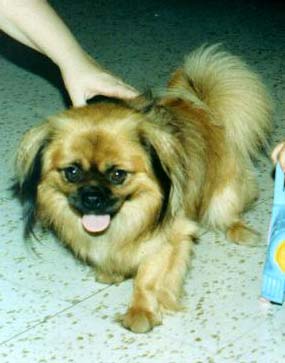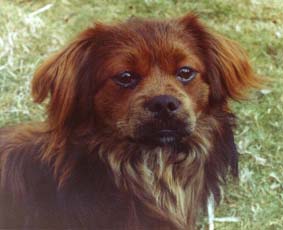





SMOOTH COATS IN LHASAS
Your puppies are four weeks when you begin to suspect it...by five weeks you're quite certain...by six weeks everyone asks you, "Why does that one look so different?" Sure enough, you've got a Prapso in your litter. How do you feel when this happens to you? Disappointed? Frustrated? Confused? One thing is for sure - there's no need to feel alone. Prapsos tend to appear quite often and result from the most carefully planned breedings. Many Lhasa champions produce them and there are many Lhasa champions that have had smooth littermates. Often there's a tendency to shift the blame to one particular dog. The truth is that Prapsos come down from many different lines; in fact, probably all lines produce them to either a greater or lesser extent. Nevertheless, some who have experienced this phenomenon in one of their litters become quite paranoid over the possibility of it happening again. Ask them to list serious problems that occur in the breed and Prapsos will be mentioned in the same breath with kidney disease, dysplasia, disc disease, gross bites, ect. Is this fair? Prapsos are healthy, happy and attractive. They are NOT diseased! They are not gross or ugly. Should they be condemned simply because they do not have a hairy face? What should one do with these pups? Because breeders are ashamed of them, they are usually hurriedly sold cheaply or given away without papers. But is it really fair that they be robbed of their heritage? Shouldn't the owner of a smooth-coated Lhasa have as much right to be proud of their pup's lineage as the owners of his heavily-coated littermates? But how do you explain their different appearance to prospective owners? Some have suggested calling them Prapsos. This term really raises more questions than it provides answers. How could they be other than Apsos when they've come down from generations of nothing but purebred registered Lhasa Apsos? Some explain that they are throwbacks as a result of interbreeding between the Lhasa Apso and the Tibetan Spaniel done by the Tibetans. If this is so, did the Tibetans perhaps view the Apso and the Spaniel as coat variations of the same breed? It's interesting to note that proponents of both breeds claim that their breed is the "Apsos Seng Kyi"' the true lion-dog of Tibet. If you've ever seen a smooth Lhasa you may been struck by the remarcable resemblence to a Tibetan Spaniel. How is it possible to have a dog of another breed result from the matings of purebreds? Is it not more logical to accept the Tibetan Spaniel as a coat variation of the Lhasa Apso?
Permission to reprint this copyrighted material has been granted to Monique van Boxtel
|

